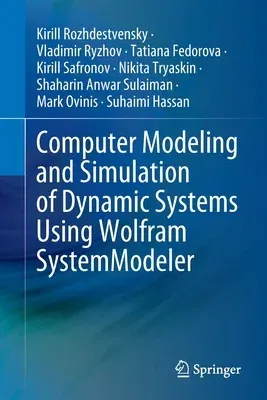Foreword
1.1. Basic concepts of modeling
1.2. Classification of mathematical models
1.3. The main properties of mathematical models
1.4. Computer modeling and computational experiment
1.5. Classification of computer models
1.6. Open and isolated models
1.7. One-component and multi-component models
1.8 Continuous, discrete and hybrid models
1.9 Linear and nonlinear systems
1.10 Component-oriented approach in modeling
2. Wolfram SystemModeler environment description
2.1. General concepts
2.2. Model Center
2.3. Simulation Center Numerical Experiment
2.3.1 Experiment Browser
2.3.2. Solver Choice
2.3.3 Graphing
2.3.4 Model Animation
2.3.5 Example Simulation Center Tools: FFT Analysis
2.4. The process of creating a dynamic model in Wolfram SystemModeler
2.4.1 Creating your own component in text mode
2.4.2 Performing a numerical experiment
2.4.3 Creating your own component library for modeling complex systems
2.5. Basics of component modeling in WSM
2.5.1 Creating a computer model of a spring pendulum: Modelica code and
component modeling
2.5.2 Analysis of the properties of the created component
2.5.3 An example of the use of created components: multi-link chain
2.6. Creating a hybrid model in WSM using Modelica features
2.6.1 Using the capabilities of the Modelica language to describe
continuous and discrete events
2.6.2 Modelica Language Example: Bouncing Ball
2.7. General recommendations for creating a computer model
3. Computer simulation of dynamic systems
3.1. Dynamic system modeling
3.2. Fundamental principles for constructing mathematical models
3.2.1 Use of Newton's laws and conservation laws
3.2.2. Variational principles
3.3 Hierarchical principles for constructing mathematical models
3.4. Universality of a computer model and equivalent physical systems
4. Modeling of mechanical oscillatory systems with one degree of
freedom. Examples
4.1. Mathematical pendulum
4.2. Galileo Pendulum
4.3. Mathematical pendulum with spring
5. Modeling of mechanical oscillatory systems with several degrees of
freedom. Examples
5.1. The movement of two bodies with friction
5.2. Mechanical system with damper and spring
5.3. The movement of three bodies connected by a damper and springs
5.4. Connected pendulums
5.5. Double pendulum
5.6. Dual torsion oscillator
5.7. Gear rotary mechanical system
5.8. Mechanical system with two springs and a block
5.9. Sophisticated mechanical system with springs and block
6. Hierarchical component models. Examples
6.1. The problem of the liquid level in a tank with a flat bottom
6.2. The problem of heating and fluid outflow from a system of two tanks
6.3. The equilibrium problem for the inverse pendulum

